System Thinking: A Path to Food Sustainability by Reducing Waste
VerifiedAdded on 2023/06/12
|9
|2714
|488
Essay
AI Summary
This essay examines the problem of food waste, particularly in the United States, through a systems thinking lens, aiming to achieve sustainability. It highlights the unsustainable nature of global food systems and focuses on household food waste as a critical issue. The essay discusses the significant impact of food loss and waste on the environment and economy, noting that a substantial portion of food produced in the US ends up in landfills. It delves into the reasons behind food waste, including consumer confusion about expiration dates and inefficient purchase planning. The analysis incorporates economic, social, and environmental aspects, emphasizing the role of consumer behavior and the wealth gap in exacerbating the problem. The essay outlines the principles of systems thinking and its application to solving complex problems like food waste. It also addresses the three pillars of sustainability—social, economic, and environmental—and their interconnectedness in the context of food waste. The conclusion advocates for a systems thinking approach to address food waste, promoting awareness and initiatives like retail food donation to reduce waste and conserve resources.
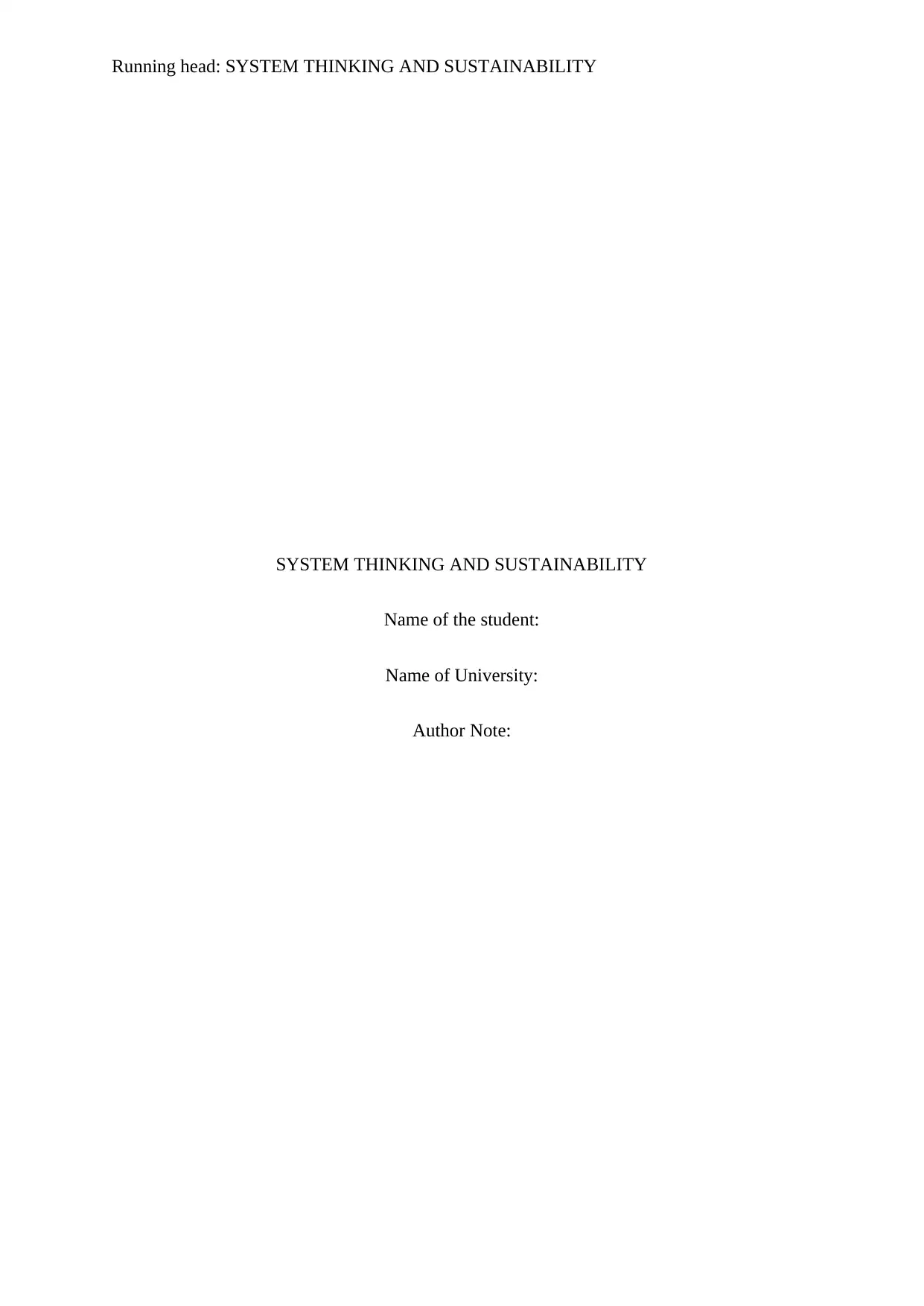
Running head: SYSTEM THINKING AND SUSTAINABILITY
SYSTEM THINKING AND SUSTAINABILITY
Name of the student:
Name of University:
Author Note:
SYSTEM THINKING AND SUSTAINABILITY
Name of the student:
Name of University:
Author Note:
Paraphrase This Document
Need a fresh take? Get an instant paraphrase of this document with our AI Paraphraser
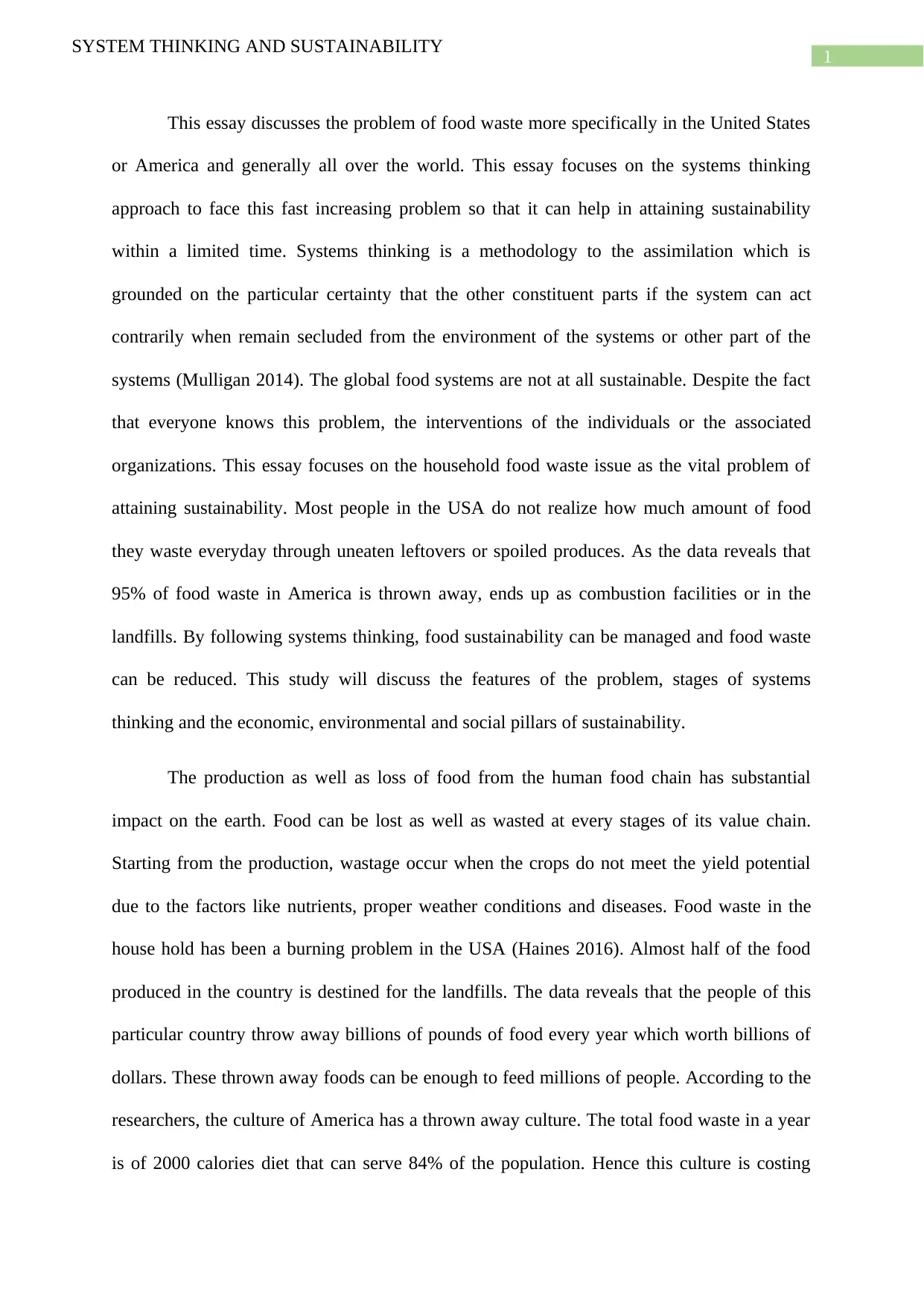
1
SYSTEM THINKING AND SUSTAINABILITY
This essay discusses the problem of food waste more specifically in the United States
or America and generally all over the world. This essay focuses on the systems thinking
approach to face this fast increasing problem so that it can help in attaining sustainability
within a limited time. Systems thinking is a methodology to the assimilation which is
grounded on the particular certainty that the other constituent parts if the system can act
contrarily when remain secluded from the environment of the systems or other part of the
systems (Mulligan 2014). The global food systems are not at all sustainable. Despite the fact
that everyone knows this problem, the interventions of the individuals or the associated
organizations. This essay focuses on the household food waste issue as the vital problem of
attaining sustainability. Most people in the USA do not realize how much amount of food
they waste everyday through uneaten leftovers or spoiled produces. As the data reveals that
95% of food waste in America is thrown away, ends up as combustion facilities or in the
landfills. By following systems thinking, food sustainability can be managed and food waste
can be reduced. This study will discuss the features of the problem, stages of systems
thinking and the economic, environmental and social pillars of sustainability.
The production as well as loss of food from the human food chain has substantial
impact on the earth. Food can be lost as well as wasted at every stages of its value chain.
Starting from the production, wastage occur when the crops do not meet the yield potential
due to the factors like nutrients, proper weather conditions and diseases. Food waste in the
house hold has been a burning problem in the USA (Haines 2016). Almost half of the food
produced in the country is destined for the landfills. The data reveals that the people of this
particular country throw away billions of pounds of food every year which worth billions of
dollars. These thrown away foods can be enough to feed millions of people. According to the
researchers, the culture of America has a thrown away culture. The total food waste in a year
is of 2000 calories diet that can serve 84% of the population. Hence this culture is costing
SYSTEM THINKING AND SUSTAINABILITY
This essay discusses the problem of food waste more specifically in the United States
or America and generally all over the world. This essay focuses on the systems thinking
approach to face this fast increasing problem so that it can help in attaining sustainability
within a limited time. Systems thinking is a methodology to the assimilation which is
grounded on the particular certainty that the other constituent parts if the system can act
contrarily when remain secluded from the environment of the systems or other part of the
systems (Mulligan 2014). The global food systems are not at all sustainable. Despite the fact
that everyone knows this problem, the interventions of the individuals or the associated
organizations. This essay focuses on the household food waste issue as the vital problem of
attaining sustainability. Most people in the USA do not realize how much amount of food
they waste everyday through uneaten leftovers or spoiled produces. As the data reveals that
95% of food waste in America is thrown away, ends up as combustion facilities or in the
landfills. By following systems thinking, food sustainability can be managed and food waste
can be reduced. This study will discuss the features of the problem, stages of systems
thinking and the economic, environmental and social pillars of sustainability.
The production as well as loss of food from the human food chain has substantial
impact on the earth. Food can be lost as well as wasted at every stages of its value chain.
Starting from the production, wastage occur when the crops do not meet the yield potential
due to the factors like nutrients, proper weather conditions and diseases. Food waste in the
house hold has been a burning problem in the USA (Haines 2016). Almost half of the food
produced in the country is destined for the landfills. The data reveals that the people of this
particular country throw away billions of pounds of food every year which worth billions of
dollars. These thrown away foods can be enough to feed millions of people. According to the
researchers, the culture of America has a thrown away culture. The total food waste in a year
is of 2000 calories diet that can serve 84% of the population. Hence this culture is costing
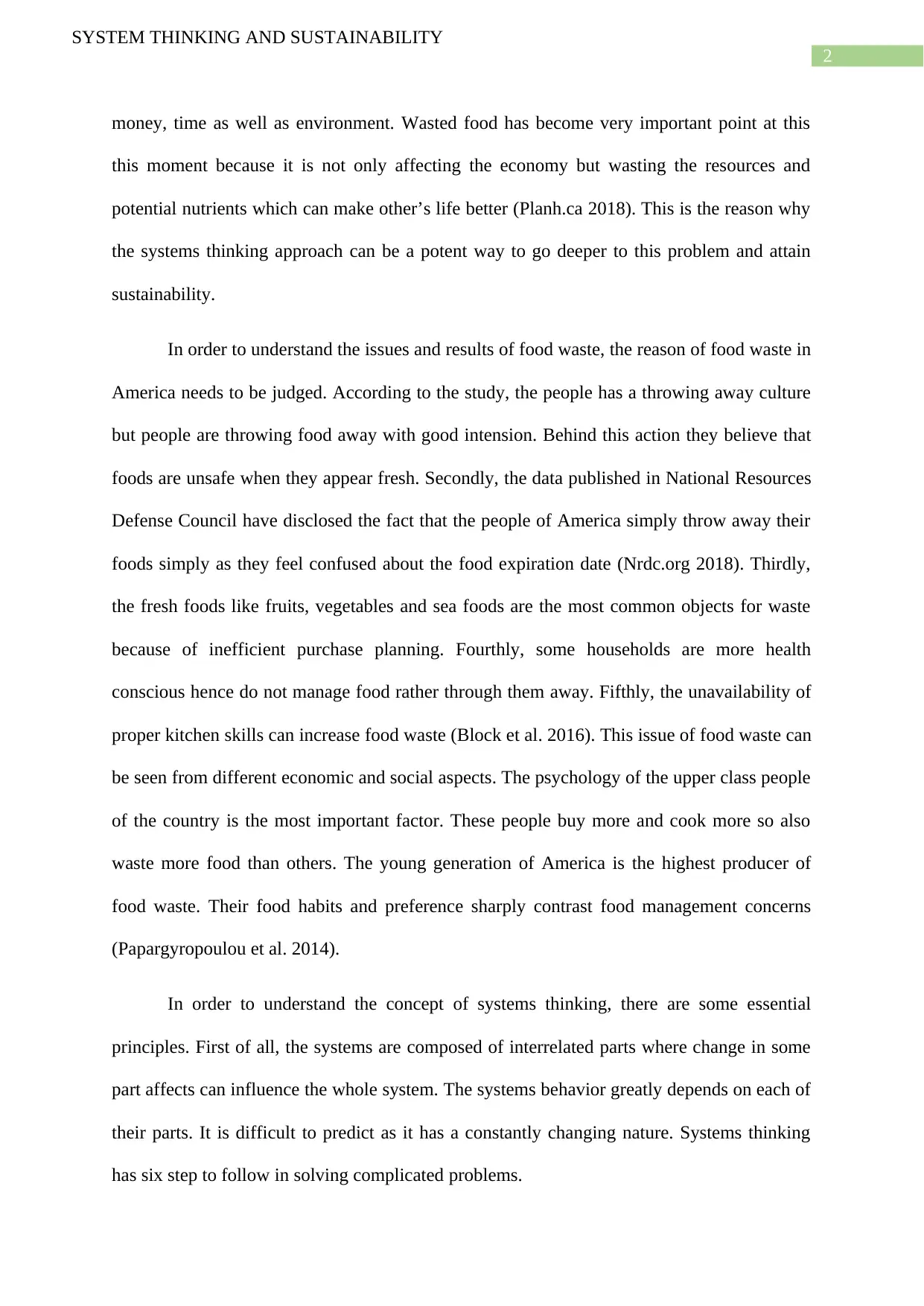
2
SYSTEM THINKING AND SUSTAINABILITY
money, time as well as environment. Wasted food has become very important point at this
this moment because it is not only affecting the economy but wasting the resources and
potential nutrients which can make other’s life better (Planh.ca 2018). This is the reason why
the systems thinking approach can be a potent way to go deeper to this problem and attain
sustainability.
In order to understand the issues and results of food waste, the reason of food waste in
America needs to be judged. According to the study, the people has a throwing away culture
but people are throwing food away with good intension. Behind this action they believe that
foods are unsafe when they appear fresh. Secondly, the data published in National Resources
Defense Council have disclosed the fact that the people of America simply throw away their
foods simply as they feel confused about the food expiration date (Nrdc.org 2018). Thirdly,
the fresh foods like fruits, vegetables and sea foods are the most common objects for waste
because of inefficient purchase planning. Fourthly, some households are more health
conscious hence do not manage food rather through them away. Fifthly, the unavailability of
proper kitchen skills can increase food waste (Block et al. 2016). This issue of food waste can
be seen from different economic and social aspects. The psychology of the upper class people
of the country is the most important factor. These people buy more and cook more so also
waste more food than others. The young generation of America is the highest producer of
food waste. Their food habits and preference sharply contrast food management concerns
(Papargyropoulou et al. 2014).
In order to understand the concept of systems thinking, there are some essential
principles. First of all, the systems are composed of interrelated parts where change in some
part affects can influence the whole system. The systems behavior greatly depends on each of
their parts. It is difficult to predict as it has a constantly changing nature. Systems thinking
has six step to follow in solving complicated problems.
SYSTEM THINKING AND SUSTAINABILITY
money, time as well as environment. Wasted food has become very important point at this
this moment because it is not only affecting the economy but wasting the resources and
potential nutrients which can make other’s life better (Planh.ca 2018). This is the reason why
the systems thinking approach can be a potent way to go deeper to this problem and attain
sustainability.
In order to understand the issues and results of food waste, the reason of food waste in
America needs to be judged. According to the study, the people has a throwing away culture
but people are throwing food away with good intension. Behind this action they believe that
foods are unsafe when they appear fresh. Secondly, the data published in National Resources
Defense Council have disclosed the fact that the people of America simply throw away their
foods simply as they feel confused about the food expiration date (Nrdc.org 2018). Thirdly,
the fresh foods like fruits, vegetables and sea foods are the most common objects for waste
because of inefficient purchase planning. Fourthly, some households are more health
conscious hence do not manage food rather through them away. Fifthly, the unavailability of
proper kitchen skills can increase food waste (Block et al. 2016). This issue of food waste can
be seen from different economic and social aspects. The psychology of the upper class people
of the country is the most important factor. These people buy more and cook more so also
waste more food than others. The young generation of America is the highest producer of
food waste. Their food habits and preference sharply contrast food management concerns
(Papargyropoulou et al. 2014).
In order to understand the concept of systems thinking, there are some essential
principles. First of all, the systems are composed of interrelated parts where change in some
part affects can influence the whole system. The systems behavior greatly depends on each of
their parts. It is difficult to predict as it has a constantly changing nature. Systems thinking
has six step to follow in solving complicated problems.
⊘ This is a preview!⊘
Do you want full access?
Subscribe today to unlock all pages.

Trusted by 1+ million students worldwide
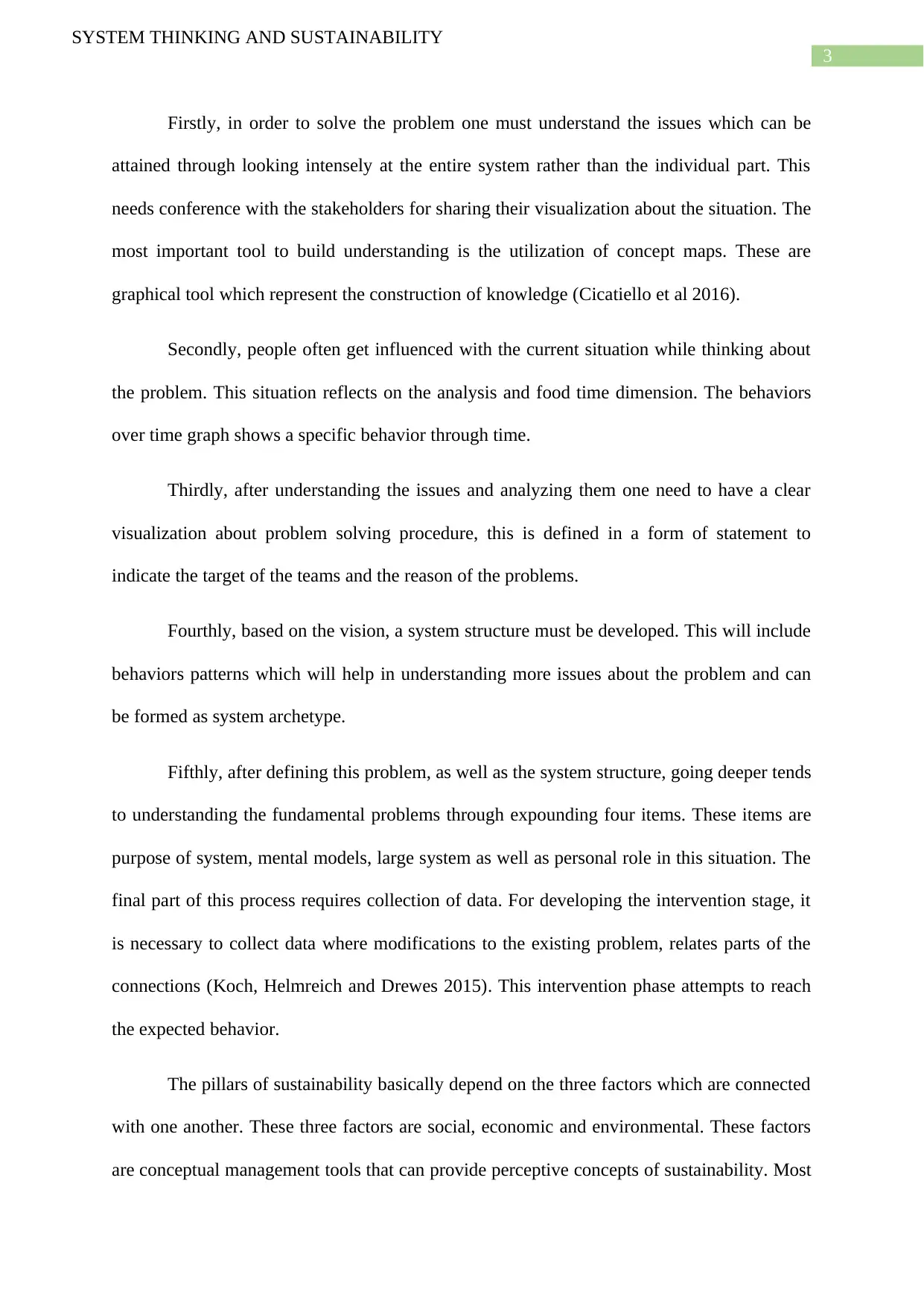
3
SYSTEM THINKING AND SUSTAINABILITY
Firstly, in order to solve the problem one must understand the issues which can be
attained through looking intensely at the entire system rather than the individual part. This
needs conference with the stakeholders for sharing their visualization about the situation. The
most important tool to build understanding is the utilization of concept maps. These are
graphical tool which represent the construction of knowledge (Cicatiello et al 2016).
Secondly, people often get influenced with the current situation while thinking about
the problem. This situation reflects on the analysis and food time dimension. The behaviors
over time graph shows a specific behavior through time.
Thirdly, after understanding the issues and analyzing them one need to have a clear
visualization about problem solving procedure, this is defined in a form of statement to
indicate the target of the teams and the reason of the problems.
Fourthly, based on the vision, a system structure must be developed. This will include
behaviors patterns which will help in understanding more issues about the problem and can
be formed as system archetype.
Fifthly, after defining this problem, as well as the system structure, going deeper tends
to understanding the fundamental problems through expounding four items. These items are
purpose of system, mental models, large system as well as personal role in this situation. The
final part of this process requires collection of data. For developing the intervention stage, it
is necessary to collect data where modifications to the existing problem, relates parts of the
connections (Koch, Helmreich and Drewes 2015). This intervention phase attempts to reach
the expected behavior.
The pillars of sustainability basically depend on the three factors which are connected
with one another. These three factors are social, economic and environmental. These factors
are conceptual management tools that can provide perceptive concepts of sustainability. Most
SYSTEM THINKING AND SUSTAINABILITY
Firstly, in order to solve the problem one must understand the issues which can be
attained through looking intensely at the entire system rather than the individual part. This
needs conference with the stakeholders for sharing their visualization about the situation. The
most important tool to build understanding is the utilization of concept maps. These are
graphical tool which represent the construction of knowledge (Cicatiello et al 2016).
Secondly, people often get influenced with the current situation while thinking about
the problem. This situation reflects on the analysis and food time dimension. The behaviors
over time graph shows a specific behavior through time.
Thirdly, after understanding the issues and analyzing them one need to have a clear
visualization about problem solving procedure, this is defined in a form of statement to
indicate the target of the teams and the reason of the problems.
Fourthly, based on the vision, a system structure must be developed. This will include
behaviors patterns which will help in understanding more issues about the problem and can
be formed as system archetype.
Fifthly, after defining this problem, as well as the system structure, going deeper tends
to understanding the fundamental problems through expounding four items. These items are
purpose of system, mental models, large system as well as personal role in this situation. The
final part of this process requires collection of data. For developing the intervention stage, it
is necessary to collect data where modifications to the existing problem, relates parts of the
connections (Koch, Helmreich and Drewes 2015). This intervention phase attempts to reach
the expected behavior.
The pillars of sustainability basically depend on the three factors which are connected
with one another. These three factors are social, economic and environmental. These factors
are conceptual management tools that can provide perceptive concepts of sustainability. Most
Paraphrase This Document
Need a fresh take? Get an instant paraphrase of this document with our AI Paraphraser
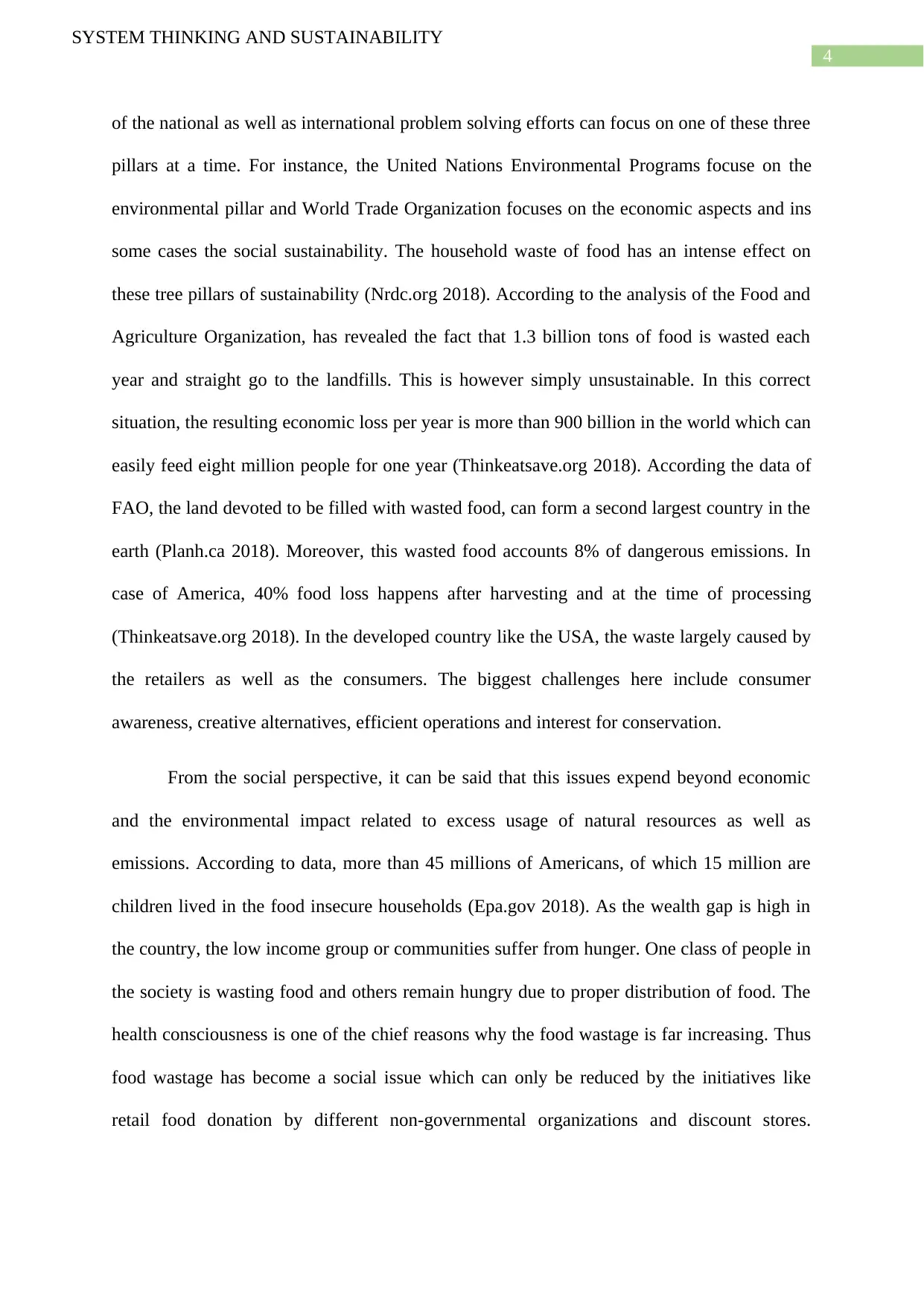
4
SYSTEM THINKING AND SUSTAINABILITY
of the national as well as international problem solving efforts can focus on one of these three
pillars at a time. For instance, the United Nations Environmental Programs focuse on the
environmental pillar and World Trade Organization focuses on the economic aspects and ins
some cases the social sustainability. The household waste of food has an intense effect on
these tree pillars of sustainability (Nrdc.org 2018). According to the analysis of the Food and
Agriculture Organization, has revealed the fact that 1.3 billion tons of food is wasted each
year and straight go to the landfills. This is however simply unsustainable. In this correct
situation, the resulting economic loss per year is more than 900 billion in the world which can
easily feed eight million people for one year (Thinkeatsave.org 2018). According the data of
FAO, the land devoted to be filled with wasted food, can form a second largest country in the
earth (Planh.ca 2018). Moreover, this wasted food accounts 8% of dangerous emissions. In
case of America, 40% food loss happens after harvesting and at the time of processing
(Thinkeatsave.org 2018). In the developed country like the USA, the waste largely caused by
the retailers as well as the consumers. The biggest challenges here include consumer
awareness, creative alternatives, efficient operations and interest for conservation.
From the social perspective, it can be said that this issues expend beyond economic
and the environmental impact related to excess usage of natural resources as well as
emissions. According to data, more than 45 millions of Americans, of which 15 million are
children lived in the food insecure households (Epa.gov 2018). As the wealth gap is high in
the country, the low income group or communities suffer from hunger. One class of people in
the society is wasting food and others remain hungry due to proper distribution of food. The
health consciousness is one of the chief reasons why the food wastage is far increasing. Thus
food wastage has become a social issue which can only be reduced by the initiatives like
retail food donation by different non-governmental organizations and discount stores.
SYSTEM THINKING AND SUSTAINABILITY
of the national as well as international problem solving efforts can focus on one of these three
pillars at a time. For instance, the United Nations Environmental Programs focuse on the
environmental pillar and World Trade Organization focuses on the economic aspects and ins
some cases the social sustainability. The household waste of food has an intense effect on
these tree pillars of sustainability (Nrdc.org 2018). According to the analysis of the Food and
Agriculture Organization, has revealed the fact that 1.3 billion tons of food is wasted each
year and straight go to the landfills. This is however simply unsustainable. In this correct
situation, the resulting economic loss per year is more than 900 billion in the world which can
easily feed eight million people for one year (Thinkeatsave.org 2018). According the data of
FAO, the land devoted to be filled with wasted food, can form a second largest country in the
earth (Planh.ca 2018). Moreover, this wasted food accounts 8% of dangerous emissions. In
case of America, 40% food loss happens after harvesting and at the time of processing
(Thinkeatsave.org 2018). In the developed country like the USA, the waste largely caused by
the retailers as well as the consumers. The biggest challenges here include consumer
awareness, creative alternatives, efficient operations and interest for conservation.
From the social perspective, it can be said that this issues expend beyond economic
and the environmental impact related to excess usage of natural resources as well as
emissions. According to data, more than 45 millions of Americans, of which 15 million are
children lived in the food insecure households (Epa.gov 2018). As the wealth gap is high in
the country, the low income group or communities suffer from hunger. One class of people in
the society is wasting food and others remain hungry due to proper distribution of food. The
health consciousness is one of the chief reasons why the food wastage is far increasing. Thus
food wastage has become a social issue which can only be reduced by the initiatives like
retail food donation by different non-governmental organizations and discount stores.
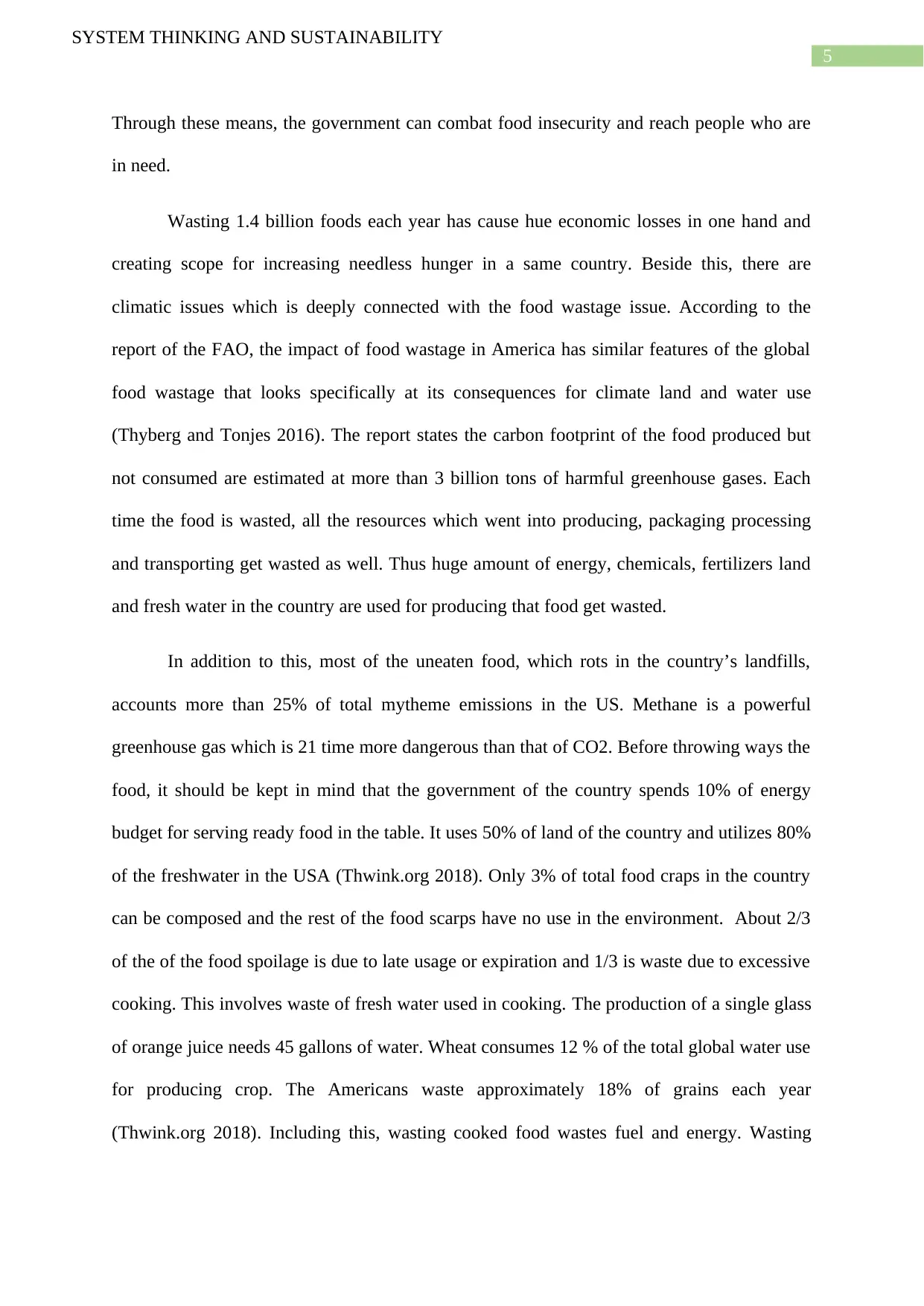
5
SYSTEM THINKING AND SUSTAINABILITY
Through these means, the government can combat food insecurity and reach people who are
in need.
Wasting 1.4 billion foods each year has cause hue economic losses in one hand and
creating scope for increasing needless hunger in a same country. Beside this, there are
climatic issues which is deeply connected with the food wastage issue. According to the
report of the FAO, the impact of food wastage in America has similar features of the global
food wastage that looks specifically at its consequences for climate land and water use
(Thyberg and Tonjes 2016). The report states the carbon footprint of the food produced but
not consumed are estimated at more than 3 billion tons of harmful greenhouse gases. Each
time the food is wasted, all the resources which went into producing, packaging processing
and transporting get wasted as well. Thus huge amount of energy, chemicals, fertilizers land
and fresh water in the country are used for producing that food get wasted.
In addition to this, most of the uneaten food, which rots in the country’s landfills,
accounts more than 25% of total mytheme emissions in the US. Methane is a powerful
greenhouse gas which is 21 time more dangerous than that of CO2. Before throwing ways the
food, it should be kept in mind that the government of the country spends 10% of energy
budget for serving ready food in the table. It uses 50% of land of the country and utilizes 80%
of the freshwater in the USA (Thwink.org 2018). Only 3% of total food craps in the country
can be composed and the rest of the food scarps have no use in the environment. About 2/3
of the of the food spoilage is due to late usage or expiration and 1/3 is waste due to excessive
cooking. This involves waste of fresh water used in cooking. The production of a single glass
of orange juice needs 45 gallons of water. Wheat consumes 12 % of the total global water use
for producing crop. The Americans waste approximately 18% of grains each year
(Thwink.org 2018). Including this, wasting cooked food wastes fuel and energy. Wasting
SYSTEM THINKING AND SUSTAINABILITY
Through these means, the government can combat food insecurity and reach people who are
in need.
Wasting 1.4 billion foods each year has cause hue economic losses in one hand and
creating scope for increasing needless hunger in a same country. Beside this, there are
climatic issues which is deeply connected with the food wastage issue. According to the
report of the FAO, the impact of food wastage in America has similar features of the global
food wastage that looks specifically at its consequences for climate land and water use
(Thyberg and Tonjes 2016). The report states the carbon footprint of the food produced but
not consumed are estimated at more than 3 billion tons of harmful greenhouse gases. Each
time the food is wasted, all the resources which went into producing, packaging processing
and transporting get wasted as well. Thus huge amount of energy, chemicals, fertilizers land
and fresh water in the country are used for producing that food get wasted.
In addition to this, most of the uneaten food, which rots in the country’s landfills,
accounts more than 25% of total mytheme emissions in the US. Methane is a powerful
greenhouse gas which is 21 time more dangerous than that of CO2. Before throwing ways the
food, it should be kept in mind that the government of the country spends 10% of energy
budget for serving ready food in the table. It uses 50% of land of the country and utilizes 80%
of the freshwater in the USA (Thwink.org 2018). Only 3% of total food craps in the country
can be composed and the rest of the food scarps have no use in the environment. About 2/3
of the of the food spoilage is due to late usage or expiration and 1/3 is waste due to excessive
cooking. This involves waste of fresh water used in cooking. The production of a single glass
of orange juice needs 45 gallons of water. Wheat consumes 12 % of the total global water use
for producing crop. The Americans waste approximately 18% of grains each year
(Thwink.org 2018). Including this, wasting cooked food wastes fuel and energy. Wasting
⊘ This is a preview!⊘
Do you want full access?
Subscribe today to unlock all pages.

Trusted by 1+ million students worldwide
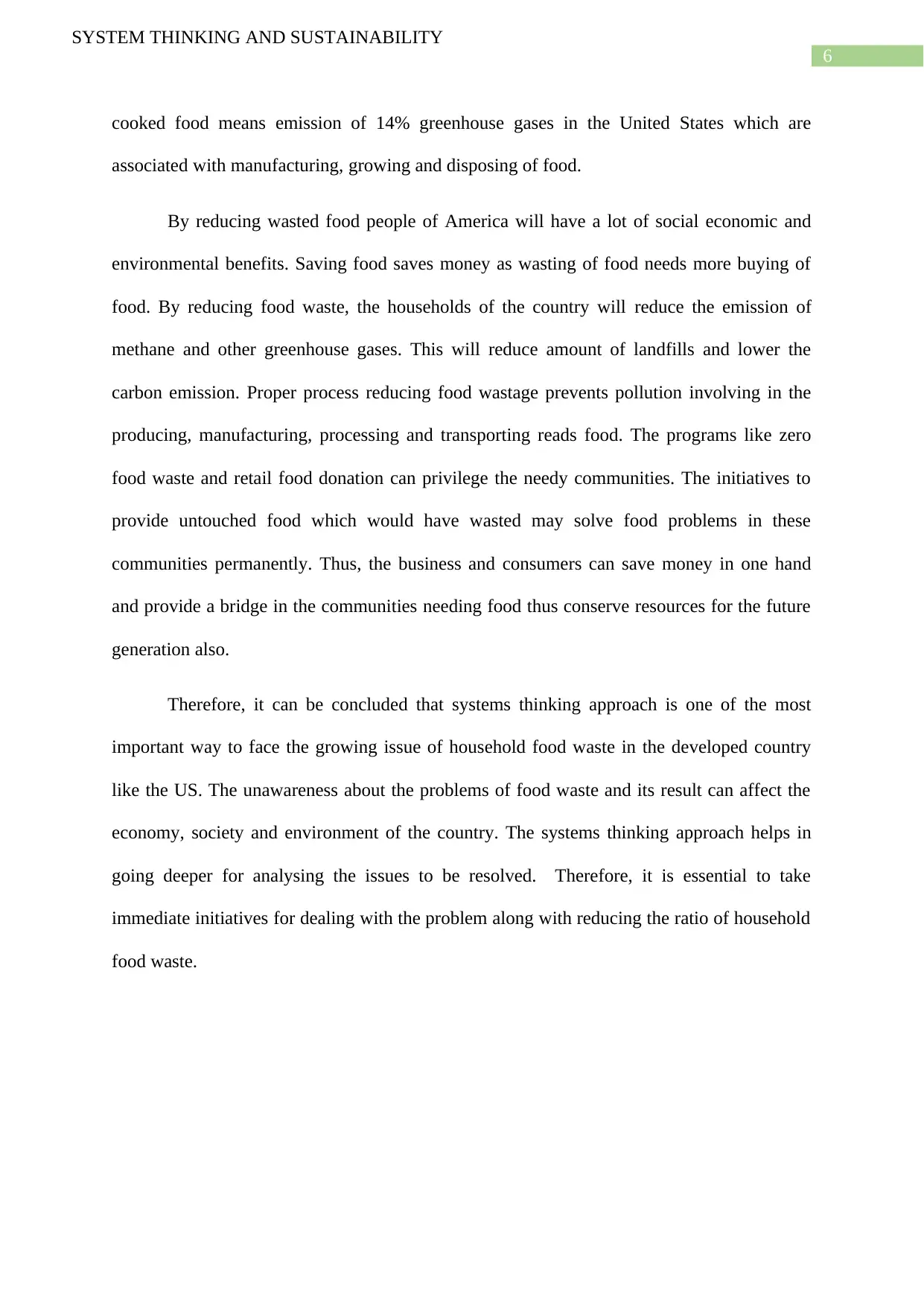
6
SYSTEM THINKING AND SUSTAINABILITY
cooked food means emission of 14% greenhouse gases in the United States which are
associated with manufacturing, growing and disposing of food.
By reducing wasted food people of America will have a lot of social economic and
environmental benefits. Saving food saves money as wasting of food needs more buying of
food. By reducing food waste, the households of the country will reduce the emission of
methane and other greenhouse gases. This will reduce amount of landfills and lower the
carbon emission. Proper process reducing food wastage prevents pollution involving in the
producing, manufacturing, processing and transporting reads food. The programs like zero
food waste and retail food donation can privilege the needy communities. The initiatives to
provide untouched food which would have wasted may solve food problems in these
communities permanently. Thus, the business and consumers can save money in one hand
and provide a bridge in the communities needing food thus conserve resources for the future
generation also.
Therefore, it can be concluded that systems thinking approach is one of the most
important way to face the growing issue of household food waste in the developed country
like the US. The unawareness about the problems of food waste and its result can affect the
economy, society and environment of the country. The systems thinking approach helps in
going deeper for analysing the issues to be resolved. Therefore, it is essential to take
immediate initiatives for dealing with the problem along with reducing the ratio of household
food waste.
SYSTEM THINKING AND SUSTAINABILITY
cooked food means emission of 14% greenhouse gases in the United States which are
associated with manufacturing, growing and disposing of food.
By reducing wasted food people of America will have a lot of social economic and
environmental benefits. Saving food saves money as wasting of food needs more buying of
food. By reducing food waste, the households of the country will reduce the emission of
methane and other greenhouse gases. This will reduce amount of landfills and lower the
carbon emission. Proper process reducing food wastage prevents pollution involving in the
producing, manufacturing, processing and transporting reads food. The programs like zero
food waste and retail food donation can privilege the needy communities. The initiatives to
provide untouched food which would have wasted may solve food problems in these
communities permanently. Thus, the business and consumers can save money in one hand
and provide a bridge in the communities needing food thus conserve resources for the future
generation also.
Therefore, it can be concluded that systems thinking approach is one of the most
important way to face the growing issue of household food waste in the developed country
like the US. The unawareness about the problems of food waste and its result can affect the
economy, society and environment of the country. The systems thinking approach helps in
going deeper for analysing the issues to be resolved. Therefore, it is essential to take
immediate initiatives for dealing with the problem along with reducing the ratio of household
food waste.
Paraphrase This Document
Need a fresh take? Get an instant paraphrase of this document with our AI Paraphraser
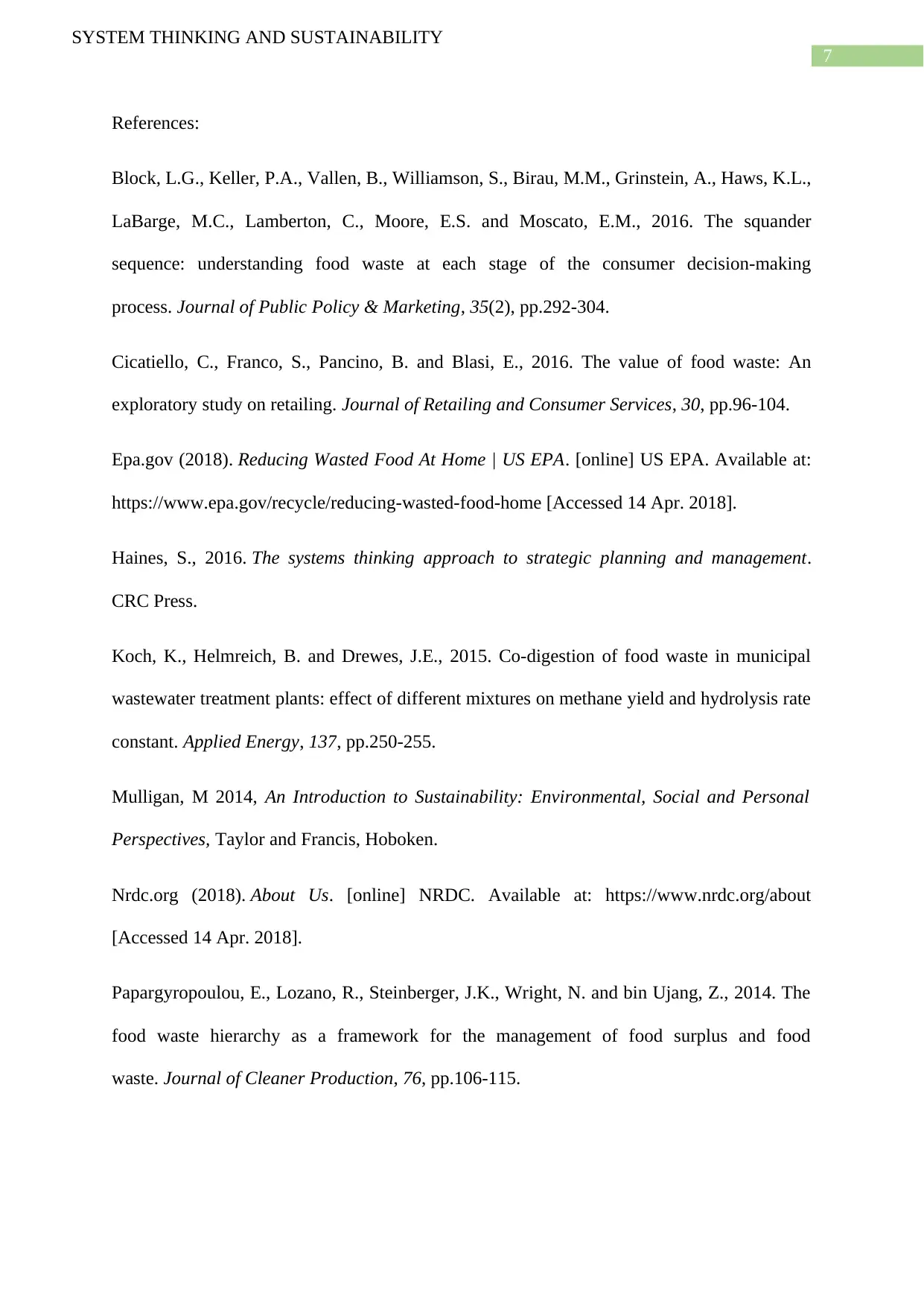
7
SYSTEM THINKING AND SUSTAINABILITY
References:
Block, L.G., Keller, P.A., Vallen, B., Williamson, S., Birau, M.M., Grinstein, A., Haws, K.L.,
LaBarge, M.C., Lamberton, C., Moore, E.S. and Moscato, E.M., 2016. The squander
sequence: understanding food waste at each stage of the consumer decision-making
process. Journal of Public Policy & Marketing, 35(2), pp.292-304.
Cicatiello, C., Franco, S., Pancino, B. and Blasi, E., 2016. The value of food waste: An
exploratory study on retailing. Journal of Retailing and Consumer Services, 30, pp.96-104.
Epa.gov (2018). Reducing Wasted Food At Home | US EPA. [online] US EPA. Available at:
https://www.epa.gov/recycle/reducing-wasted-food-home [Accessed 14 Apr. 2018].
Haines, S., 2016. The systems thinking approach to strategic planning and management.
CRC Press.
Koch, K., Helmreich, B. and Drewes, J.E., 2015. Co-digestion of food waste in municipal
wastewater treatment plants: effect of different mixtures on methane yield and hydrolysis rate
constant. Applied Energy, 137, pp.250-255.
Mulligan, M 2014, An Introduction to Sustainability: Environmental, Social and Personal
Perspectives, Taylor and Francis, Hoboken.
Nrdc.org (2018). About Us. [online] NRDC. Available at: https://www.nrdc.org/about
[Accessed 14 Apr. 2018].
Papargyropoulou, E., Lozano, R., Steinberger, J.K., Wright, N. and bin Ujang, Z., 2014. The
food waste hierarchy as a framework for the management of food surplus and food
waste. Journal of Cleaner Production, 76, pp.106-115.
SYSTEM THINKING AND SUSTAINABILITY
References:
Block, L.G., Keller, P.A., Vallen, B., Williamson, S., Birau, M.M., Grinstein, A., Haws, K.L.,
LaBarge, M.C., Lamberton, C., Moore, E.S. and Moscato, E.M., 2016. The squander
sequence: understanding food waste at each stage of the consumer decision-making
process. Journal of Public Policy & Marketing, 35(2), pp.292-304.
Cicatiello, C., Franco, S., Pancino, B. and Blasi, E., 2016. The value of food waste: An
exploratory study on retailing. Journal of Retailing and Consumer Services, 30, pp.96-104.
Epa.gov (2018). Reducing Wasted Food At Home | US EPA. [online] US EPA. Available at:
https://www.epa.gov/recycle/reducing-wasted-food-home [Accessed 14 Apr. 2018].
Haines, S., 2016. The systems thinking approach to strategic planning and management.
CRC Press.
Koch, K., Helmreich, B. and Drewes, J.E., 2015. Co-digestion of food waste in municipal
wastewater treatment plants: effect of different mixtures on methane yield and hydrolysis rate
constant. Applied Energy, 137, pp.250-255.
Mulligan, M 2014, An Introduction to Sustainability: Environmental, Social and Personal
Perspectives, Taylor and Francis, Hoboken.
Nrdc.org (2018). About Us. [online] NRDC. Available at: https://www.nrdc.org/about
[Accessed 14 Apr. 2018].
Papargyropoulou, E., Lozano, R., Steinberger, J.K., Wright, N. and bin Ujang, Z., 2014. The
food waste hierarchy as a framework for the management of food surplus and food
waste. Journal of Cleaner Production, 76, pp.106-115.
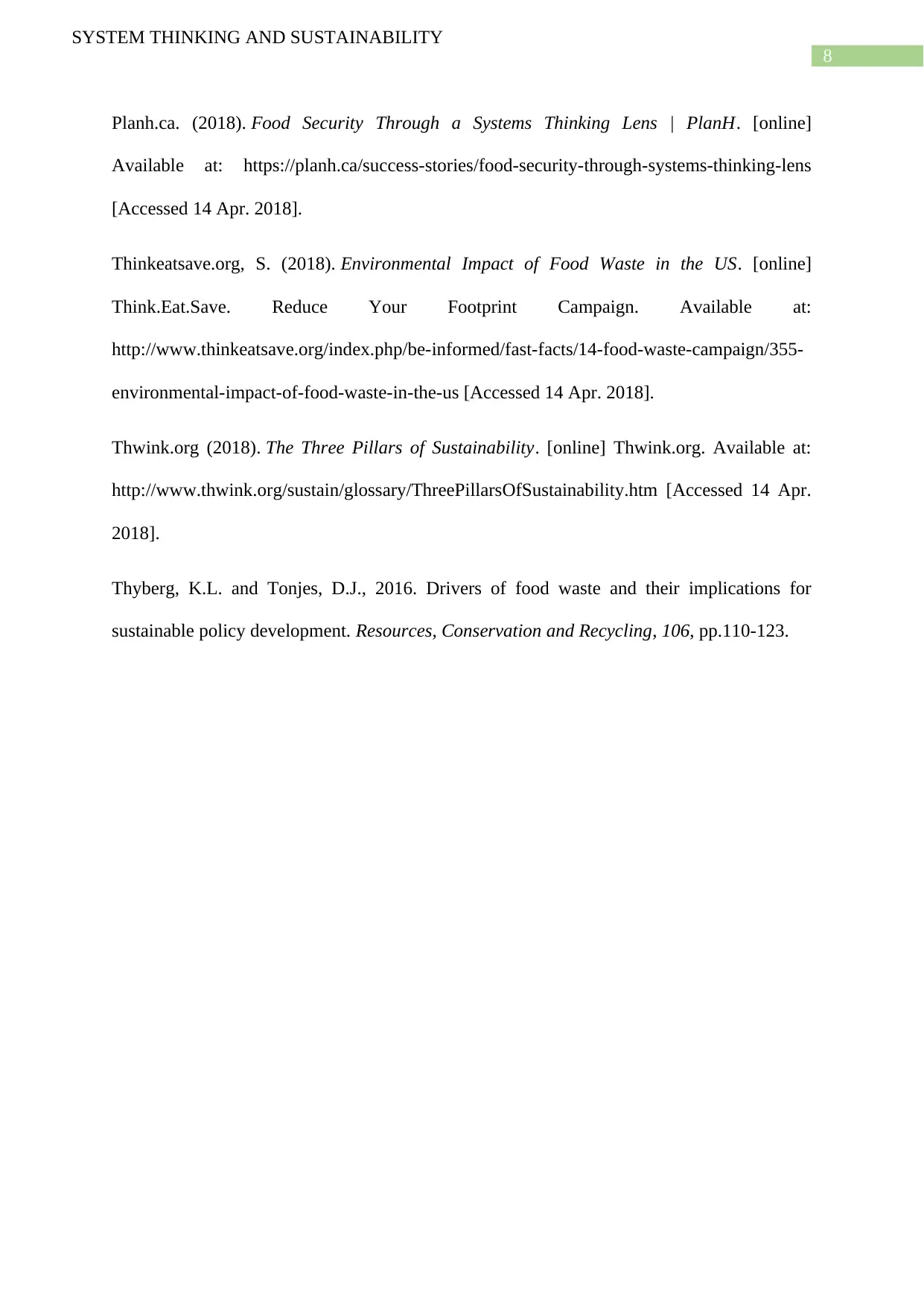
8
SYSTEM THINKING AND SUSTAINABILITY
Planh.ca. (2018). Food Security Through a Systems Thinking Lens | PlanH. [online]
Available at: https://planh.ca/success-stories/food-security-through-systems-thinking-lens
[Accessed 14 Apr. 2018].
Thinkeatsave.org, S. (2018). Environmental Impact of Food Waste in the US. [online]
Think.Eat.Save. Reduce Your Footprint Campaign. Available at:
http://www.thinkeatsave.org/index.php/be-informed/fast-facts/14-food-waste-campaign/355-
environmental-impact-of-food-waste-in-the-us [Accessed 14 Apr. 2018].
Thwink.org (2018). The Three Pillars of Sustainability. [online] Thwink.org. Available at:
http://www.thwink.org/sustain/glossary/ThreePillarsOfSustainability.htm [Accessed 14 Apr.
2018].
Thyberg, K.L. and Tonjes, D.J., 2016. Drivers of food waste and their implications for
sustainable policy development. Resources, Conservation and Recycling, 106, pp.110-123.
SYSTEM THINKING AND SUSTAINABILITY
Planh.ca. (2018). Food Security Through a Systems Thinking Lens | PlanH. [online]
Available at: https://planh.ca/success-stories/food-security-through-systems-thinking-lens
[Accessed 14 Apr. 2018].
Thinkeatsave.org, S. (2018). Environmental Impact of Food Waste in the US. [online]
Think.Eat.Save. Reduce Your Footprint Campaign. Available at:
http://www.thinkeatsave.org/index.php/be-informed/fast-facts/14-food-waste-campaign/355-
environmental-impact-of-food-waste-in-the-us [Accessed 14 Apr. 2018].
Thwink.org (2018). The Three Pillars of Sustainability. [online] Thwink.org. Available at:
http://www.thwink.org/sustain/glossary/ThreePillarsOfSustainability.htm [Accessed 14 Apr.
2018].
Thyberg, K.L. and Tonjes, D.J., 2016. Drivers of food waste and their implications for
sustainable policy development. Resources, Conservation and Recycling, 106, pp.110-123.
⊘ This is a preview!⊘
Do you want full access?
Subscribe today to unlock all pages.

Trusted by 1+ million students worldwide
1 out of 9
Related Documents
Your All-in-One AI-Powered Toolkit for Academic Success.
+13062052269
info@desklib.com
Available 24*7 on WhatsApp / Email
![[object Object]](/_next/static/media/star-bottom.7253800d.svg)
Unlock your academic potential
Copyright © 2020–2025 A2Z Services. All Rights Reserved. Developed and managed by ZUCOL.




